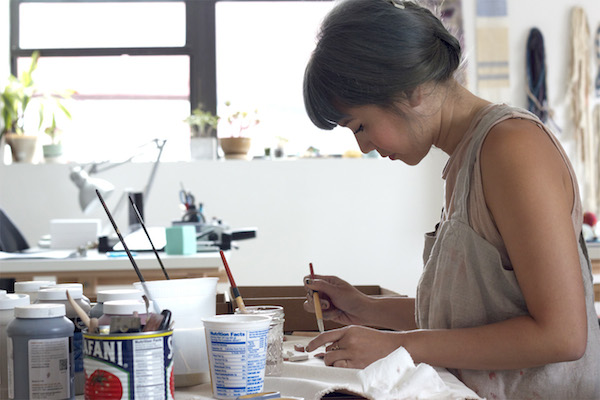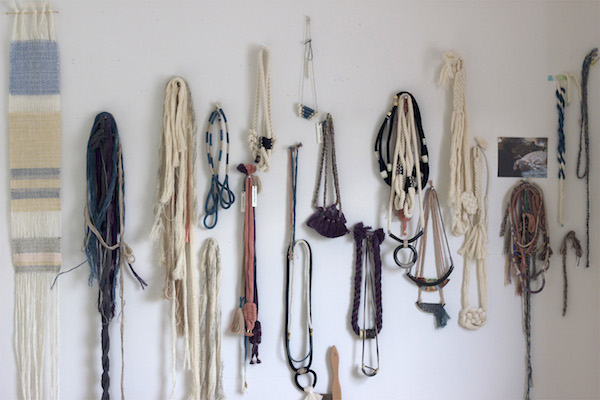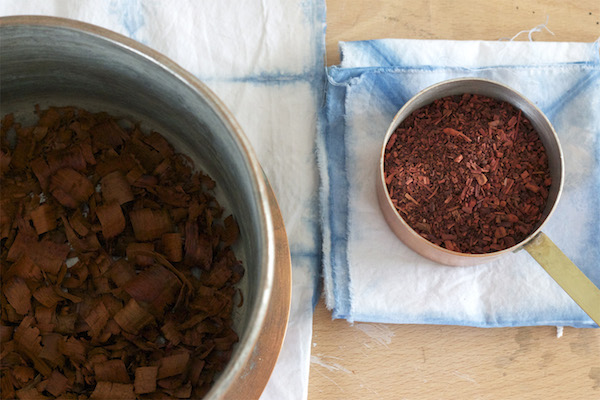We always love seeing how Botanical Colors can be applied to so many different mediums through the hands of talented artists.
Brooklyn-based Lily Piyathaisere of Gamma Folk is new to our natural dye family and we are pretty crazy about her jewelry. Lily says her vision is to “combine traditional techniques with thoughtful, statement jewelry. Influenced by folk art, mysticism, pop culture and the bauhaus, Gamma Folk is a celebration of aesthetics, experiments in technique and the preservation of craft. ”
All pieces are made by hand in Brooklyn, New York. We caught up with her recently to see what got her from the west coast to the east and what inspires her to create.
On your About page you talk about your designs being inspired by traditional techniques-tell me about some you love.
Natural dyeing is a big part of my work and that’s been traced back to the neolithic period. But more specifically, my latest experiment has been trying out a fermentation indigo vat which uses natural fermentation using bran and madder root instead of harsh chemicals. Before this I was using a ferrous vat (iron) which products beautiful dark blue and great for cotton, but not so much for silks.
Also, I incorporate knotting and braiding into my jewelry and who better to learn techniques from than fisherman and Boy Scouts? The techniques range from functional and decorative knotwork including net making knots, turks head knots and my current favorite, basket weave knots. It;s a vast world of knots out there.
How important is fiber to you as form when designing?
Fiber is the framework from where my work begins. The pliability, weight, strength, sheen, type of yarn, how well it takes natural dyes and where it comes from are all taken into consideration when designing jewelry. And naturally, a fiber necklace will wear differently over time than metal necklace but it still carries age well as well as the natural dye. At first, all my work was cotton, but I’ve become more sensitive to other materials including linen, bamboo and silk.
Also, I recently raised some Peace Silk worms which gave me a new appreciation for those little creatures spinning our silks! Once they’ve fatten up from mulberry leaves, they start spinning a cocoon which they do all day for about 4-6 days. Talk about dedication. And once they emerge as moths, you wouldn’t believe how strong their cocoons are (also how many silkworms it takes to make a skein of yarn) -that experience gave me a new perspective on silk production.
You left California in 2012 for Brooklyn-how has place inspired your work?
I’ve spent the majority of my life in California–grew up in the northern part and went to school in southern California and then moved back up to San Francisco for a few years before Brooklyn. It wasn’t until I was in Brooklyn that I revisited weaving or learned natural dyeing which probably has to do with the community and resources available in Brooklyn. It was easy to meet artists and other like-minded folks interested in similar things. I know that exists in San Francisco and Oakland, but it was harder for me to tap into.
In terms of the visual landscape and how that affects my work, I’m still inspired by a lot of the same parts of nature as I was in California, they’re just a bit different here. Having four seasons has been a big change, which I love. I had never lived in snow, experienced a hurricane or even saw a lighting bug until moving here. All magical things! Also the textures of the city, architecture, people and street trees are all inspirational in their own right.
Who is the woman you are designing for?
She is interested in being an individual, believes in self expression through style, has an appreciation for art and is interested in knowing where and how the pieces are made. She feels good about buying them and in turn having a positive connection to it.
What are some of your favorite dye colors? Do you mix them to make signature colors?
I love the range of corals and salmon pinks I get with madder root, the warm and cold greys I can get from mixing black walnut with mordants, the deeper greys with Logwood and who doesn’t love indigo? Since the color palette is all from the earth, I believe mixing them naturally makes them work together.







Comments are closed.